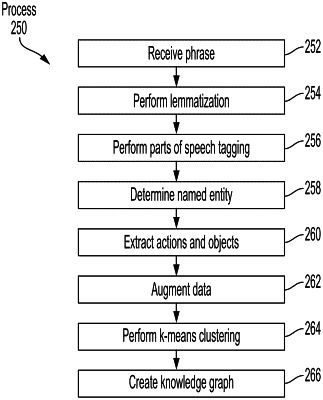| CPC G10L 15/197 (2013.01) [G10L 15/063 (2013.01); G10L 2015/0631 (2013.01)] | 4 Claims |

|
1. A method for training and applying a knowledge graph data structure for a spoken language understanding (SLU) system, the method performed by a system comprising one or more processors, the method comprising:
receiving input training data representing one or more phrases;
training a knowledge graph data structure, the training comprising:
extracting word data representing one or more words from the input training data representing one or more phrases;
generating and storing, based on the word data representing the one or more words, a named entity node in the knowledge graph data structure;
generating taxonomy data representing one or more categories in which the one or more phrases of the input training data can be segmented;
generating and storing, based on the taxonomy data, a taxonomy node in the knowledge graph data structure;
generating intent data based on the input training data representing the one or more phrases;
generating and storing, based on the intent data, an intent node in the knowledge graph; and
generating and storing a first edge and a second edge in the knowledge graph,
wherein the first edge forms a first connection between the named entity node and the taxonomy node, and the second edge forms a second connection between the taxonomy node and the intent node;
receiving user input phrase data; and
applying one or more data processing operations, based at least in part on the user input phrase data and the trained knowledge graph data structure comprising the named entity node, the taxonomy node, the intent node, the first edge, and the second edge, to generate output data representing a final intent of the user input phrase data, wherein the one or more data processing operations comprises:
determining one or more potential intents of the user input phrase data; and
based on the determined one or more potential intents and using a covariance matrix, determine the final intent of the user input phrase data, wherein the final intent of the user input phrase data is determined based on a maximum value of the covariance matrix.
|